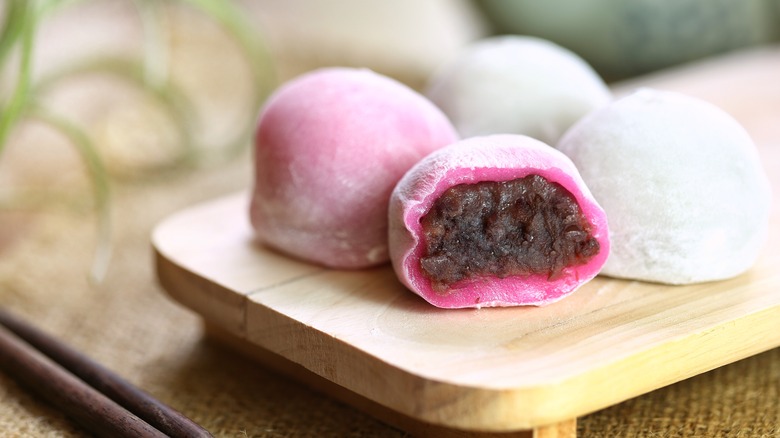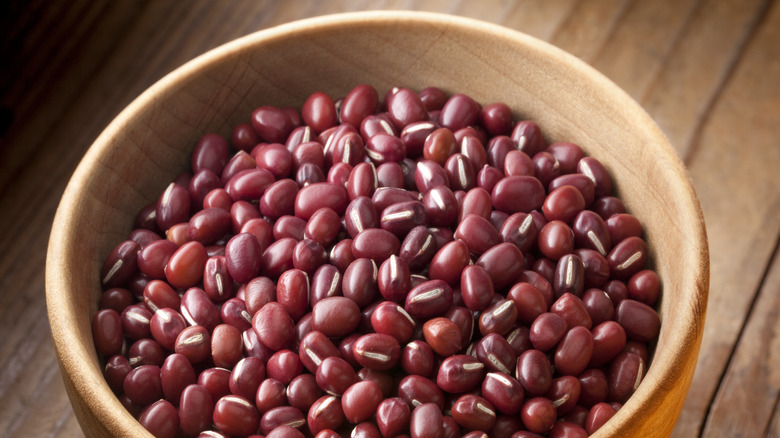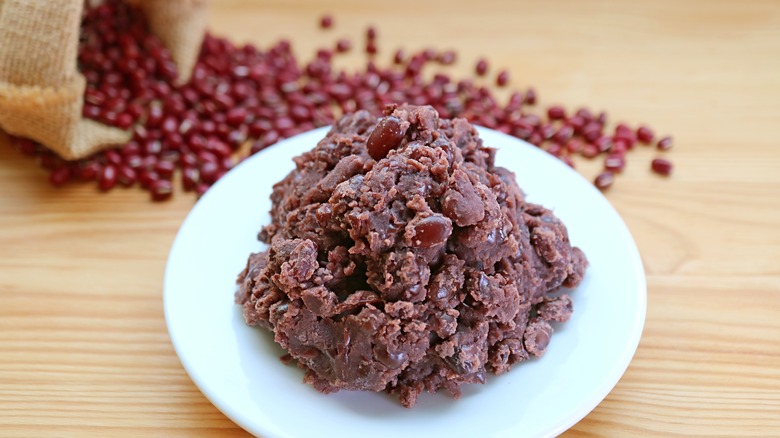How Adzuki Beans Transform Into The Sweet Paste That Stars In Mochi
If you've ever tried traditional mochi, you've tasted the sweet, reddish-brown paste at the center of the little balls of rice flour. Known as anko, or red bean paste, it's a staple of Japanese confectionery. But what exactly is it? Made from adzuki beans and sugar, anko paste is rich and flavorful. The beans lend a slightly nutty flavor that complements the sweetness of the sugar.
According to legend, anko originated as an early version of the faux meats that line store shelves these days. During the Heian period, which lasted from 794 to 1185, travelers from China introduced steamed buns filled with meat and vegetables to Japan. To make a meat-free version that aligned with their vegetarian values, Buddhist monks filled the buns with beans as a substitute.
While Japanese cooks experimented with sweetening anko throughout the following centuries, it wasn't until the Edo period (1603-1868), when Dutch traders brought sugar to Japan, that sweetened bean paste became a staple in Japanese confections. Aside from mochi, anko is also used in manjū, a mochi-like pastry made from wheat flour rather than rice flour; taiyaki, a crispy, fish-shaped pastry; and layered between miniature pancakes to make dorayaki, a Japanese sandwich cookie. Akno isn't unique to Japan, though — red bean paste is popular throughout East Asia. In Korea, it's called danpat. In Chinese cuisine, it's known as dòushā.
What are adzuki beans?
For Americans, the words "red bean paste" may conjure images of kidney beans or small red beans. Both are referred to as "red beans" in the United States, and both are distinct from adzuki beans. Adzuki beans are also known as red mung beans, since they're closely related to mung beans, another popular food throughout Asia. Adzuki beans grow in temperate or semitropical areas, and historians believe that they may have been domesticated independently in Japan, Korea, and China. While they have a slightly sweet taste, they're used in savory dishes, too. Even if you don't have much of a sweet tooth, you can enjoy adzuki beans in curries, salads, soups, and stews.
Throughout history, they have been used in traditional medicine. Modern science agrees: Adzuki beans are remarkably nutritious. According to Healthline, they're packed with fiber, protein, and antioxidants. They're good for your gut and show promise for diabetes research. A 2012 study found that legumes can help improve glycemic control, and a 2014 animal study suggested that extract from adzuki beans could be used to treat diabetes, too.
How is anko made?
Anko is generally either "chunky" or "smooth," just like peanut butter. "Chunky" anko is called tsubuan and is made with partially crushed beans with the skins still attached. "Smooth" anko, or koshian, is ground into a fine paste. Traditionally, koshian was made through a laborious process that involved mushing the beans through a fine mesh sieve to remove the skins, then bathing the beans in water to filter them. Now, home cooks can simplify the process by blending whole beans in a food processor. Some professionals still stick to the old ways, though, since removing the skins entirely results in a smoother texture and a lighter taste.
The beans are boiled — sometimes multiple times — in water to remove any astringency and to soften. Depending on the type of anko, they're then blended, pushed through a strainer, or left be. Next, the beans are cooked with sugar until they begin to form a thick paste, generally in a 1:1 ratio of sugar to beans. Once the anko has cooked, it can be stored in an airtight container for up to 3-4 months — the high sugar content helps preserve it. Chinese cooks use a similar process to make dòushā but typically add in some type of fat. Lard, peanut oil, and vegetable oil are popular choices. The addition of fat results in a rich, fragrant paste.


